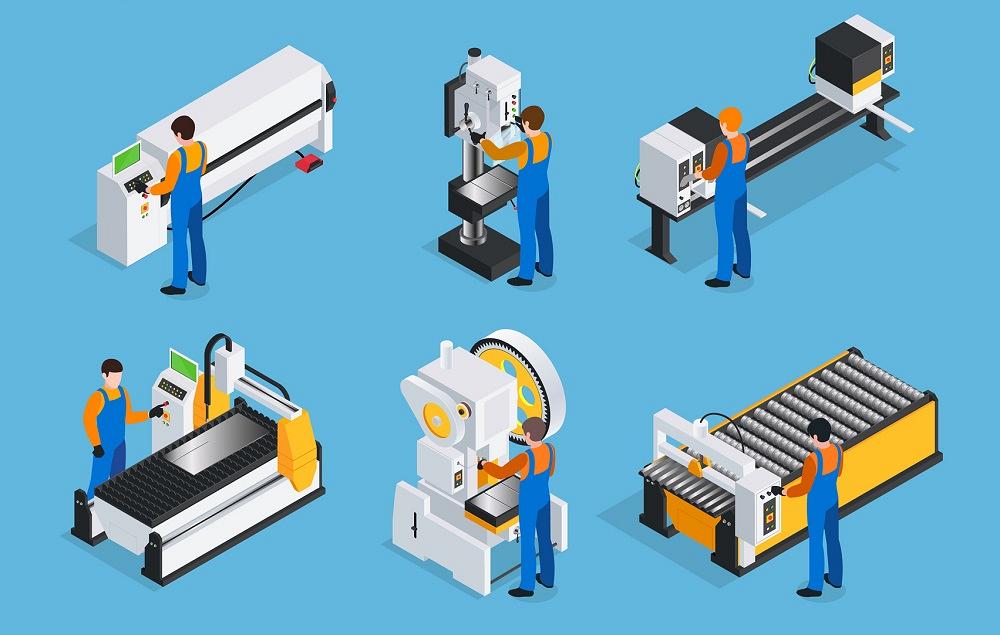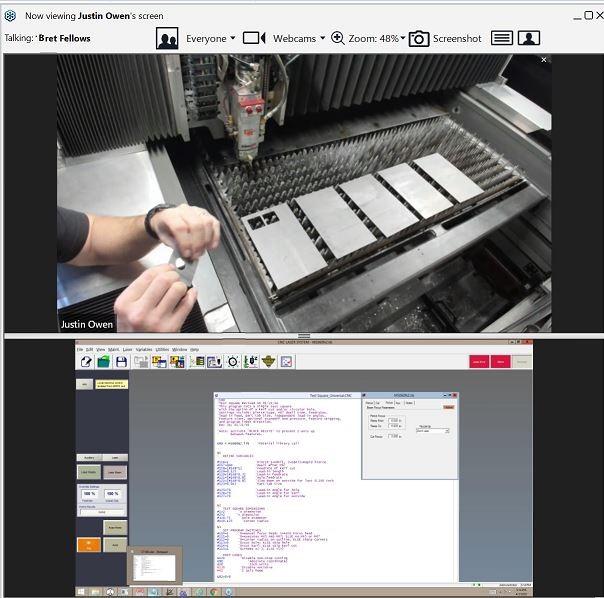Marketing and Communications Manager
- FMA
- The Fabricator
- FABTECH
- Canadian Metalworking
Categories
- Additive Manufacturing
- Aluminum Welding
- Arc Welding
- Assembly and Joining
- Automation and Robotics
- Bending and Forming
- Consumables
- Cutting and Weld Prep
- Electric Vehicles
- En Español
- Finishing
- Hydroforming
- Laser Cutting
- Laser Welding
- Machining
- Manufacturing Software
- Materials Handling
- Metals/Materials
- Oxyfuel Cutting
- Plasma Cutting
- Power Tools
- Punching and Other Holemaking
- Roll Forming
- Safety
- Sawing
- Shearing
- Shop Management
- Testing and Measuring
- Tube and Pipe Fabrication
- Tube and Pipe Production
- Waterjet Cutting
Industry Directory
Webcasts
Podcasts
FAB 40
Advertise
Subscribe
Account Login
Search
Remote instruction for metal fabricating employees
Three themes for a successful remote training program: format, engagement, and sustainability
- By Matt Garbarino and Robert Farrell Jr.
- June 5, 2020
- Article
- Shop Management

The metal fabrication and the rest of the manufacturing industry are scrambling to get up to speed on effective, safe, and affordable in-house training options. There are three themes to focus on for a successful remote training program: format, engagement, and sustainability. Getty Images
If you own or manage a company that cuts, bends, or otherwise processes metal, you no doubt have a lot on your mind right now. And here’s something more to think about: Your workforce is going to require training at some point soon.
Nothing new about that.
What is different, however, is how training is likely to take place. From those who provide instruction to those on the receiving end, there will be changes. Here are some things to be aware of as you prepare to experience the new normal of workforce training.
Since the early weeks of 2020, “lights-out production” has taken on a whole new meaning, with many manufacturing facilities going dark. Today as the industry awakens, most of these same companies are blowing off the dust, flipping on the lights, and rebooting operations. Just like before the pandemic shutdown, employee training and education remain vital. And now, against the backdrop of social distancing, travel restrictions, and tight budgets, effective remote instruction is more important than ever.
To understand the related challenges, you need to look no further than the recent in-home learning experience. Students, instructors, and professionals at all levels were forced to implement and execute learning programs with little to no advanced warning or preparation. With no training, limited bandwidth, and disparate technologies, results of this early attempt at distant learning were, by most accounts, marginal at best. As constructed and implemented, this initial approach to distant learning and teaching isn’t consistent with an effective digital remote training model and offers no value for workforce training.
With most of their attention focused on the shop floor, fabricators today face similar challenges, as many are simply ill-prepared for the impending training paradigm shift. The fabrication industry has lagged in terms of its use of collaborative technologies, smart devices, and e-learning approaches. With the sudden realization that training will, for the foreseeable future, be conducted in-house rather than at off-site conferences and OEM training facilities, many on all sides are scrambling to get up to speed on effective, safe, and affordable options.
It’s important for fabricators setting out on the training journey to see the big picture. Three interrelated themes are significant for a successful remote training program: training formats, engagement, and sustainability.
Training Formats
The ongoing evolution of fabrication requires owners, management, and shop floor personnel to keep pace with emerging trends, new technologies, enhanced processes, and best practices. Most manufacturing companies routinely experience two types of training: classroom-based instruction and hands-on machine operation.
Classroom Instruction. Classroom training, often provided in a lecture format, might include such fabrication-related topics as software user training, tips for optimizing laser cutting, bending fundamentals, best methods to import solid models, and nesting for scrap reduction. This subject matter is generally straightforward and lends itself well to a lecture or workshop format. What’s more, this type of training can be conducted in real time, providing interaction among trainer and trainee or in recorded mode, allowing participants to proceed at their own pace.
Relatively speaking, this type of training is easily implemented, requiring a laptop, tablet, or similar device; connectivity (internet/cloud/cellular); a learning environment; and access to commercial, off-the-shelf platforms such as YouTube, Go to Webinar, Microsoft Teams, and Zoom. These low-cost (often free) applications are mobile, easy to use, available through practically any smart device, and allow multiple attendees to collaborate from dispersed locations.

With Cincinnati's remote training program, fabricators are able to see both a live stream of an instructor working in front of a press brake and the instructor’s control screen while sitting through a remote training session. Image provided by Cincinnati Incorporated
Many software vendors currently offer such classes, either directly or via an approved third party, and the scope and availability of such courses will only increase. Evidence suggests this type of e-learning can be more effective than traditional training. Some research shows that, on average, those receiving online instruction retain nearly six times more material compared to a traditional classroom.
With limited seating, partitioning, and other social distancing dividers, an early version of this learning environment might look very different than what follows as social distancing restrictions ease. In the near term, however, spacing trainees 6 ft. apart will mean the average conference room will accommodate only a handful of attendees at a time. Companies should plan room layouts and schedules accordingly. Remember, a dynamic and collaborative learning environment can be valuable. Consider ways to configure space to maximize attendance, allowing trainees to interact and leverage each other’s input, insight, and problem-solving.
Hands-on Shop Floor Training. Unlike software or safety training, for example, machine operator training doesn’t lend itself especially well to a lecture. Because there are many variables to be taught and understood, such as complexity of the machine, type of cutting or bending operation, material type and thickness, new features, seldom used features, programming, troubleshooting, and maintenance, face-to-face, hands-on instruction remains the best option.
This is not to suggest that remote shop floor operator training cannot be effectively implemented. Just a few decades ago, good remote training for a specific machine’s operation would have been (pardon the pun) virtually impossible. While remote operator training is challenging, more machine tool OEMS are beginning to consider this option. Thanks in large part to the internet, high-resolution video, and supporting technologies, remote operator training is quickly becoming a viable option with real-time connection to the instructor.
It’s All About Engagement
Remote training is all about engaging people effectively. But as collaborative tools and trends are evolving, workforce demographics are changing.
For trainers this means keeping abreast of the latest technologies and evolving methods for engaging current and future customers. For fabricators, this means giving their staff options to pursue the training methods they’re most comfortable with.
As baby boomers exit the workforce, training preferences will likely continue to shift toward digital, mobile, and web-/cloud-based methods. This means engaging people with smartphones, tablets, and Google glasses.
Distance learning, even for the intricate operation of lasers, press brakes, and additive manufacturing machinery, can be very successful. With a video link to an instructor, machine, and console, trainees can follow audio and visual instruction and interact with instructors in real time, just as if they were on-site.
Success = Sustainability
Establishing a remote training process requires a level of commitment. And the best way to ensure long-term commitment is to see results. In the near term, however, be prepared to adjust your expectations. Training is a journey, not a destination. The going may be slow as you figure things out; just be sure to keep improving.
Don’t be overwhelmed at the thought of remote training. This shouldn’t entail an overhaul or disruption to your facilities or operations. On the other hand, it’s not as simple as putting a couple of laptops in a conference room. Be prepared to implement some changes and invest in any needed hardware and software.

A Cincinnati remote training session providing an overview of laser cutting machine operations gives the instructor the opportunity to offer the fabricator multiple views of the equipment and the machine’s control screen. Image provided by Cincinnati Incorporated
As you move forward, keep a few things in mind to make your remote training experience effective and constantly improving:
- Work with your vendors. Chances are your machine and software providers are rolling out remote training programs, or already have. Learn their plans for remote training, discuss courses, and find out what is coming and when.
- Appoint an employee to facilitate and advance remote learning. Allow that person to be responsible for everything from setting up and maintaining training facilities and schedules to monitoring effectiveness and evaluating emerging applications. It doesn’t have to be a full-time job, but it does require ongoing attention.
- Get your head in the cloud. A remote learning transition boils down to finding a technology system with communications capabilities that are simple, user-friendly, connected to education apps, and enabled for remote learning initiatives. The good news is that cloud technologies make it remarkably easy to access remote learning options.
- Update your technology. Make sure you have the equipment necessary to facilitate effective learning and establish a permanent learning environment dedicated to its use.
- Know the restrictions mandated by health agencies. These restrictions may affect training room configuration and capacity. Make sure that trainees have the necessary space and equipment for comfortable, distraction-free learning, while keeping in mind that social distancing restrictions will be lifted in the future.
- Make sure employees understand how to use the technology. Don’t just hand them a tablet and leave them to figure it out. And demo the technology before using it in the training. This will help prevent unforeseen glitches while allowing you to quickly determine whether the technology is relevant to your audience.
Simulated Learning
In some industries simulation is used to provide solitary and remote hands-on instruction. Construction equipment operators, for example, routinely are trained (and even certified) on virtual reality simulators. These computer-generated training aids allow trainees to experience real-life interaction with equipment ranging from forklifts and backhoes to large cranes. Visual simulators can be enhanced with augmented reality to create a more complete and realistic learning environment, involving multiple senses such as touch and sounds.
Such technologies, including mixed reality, where digital and physical objects interact in real time, are becoming more practical and adapted to training. It’s just a matter of time until these and other current and emerging technologies are commonplace throughout the fabrication industry.
What’s Ahead?
It’s safe to say that remote training will only increase over the coming weeks, months, and years. Even before the COVID-19 pandemic, remote training was gaining momentum. The infrastructure has been in place to support its effective and widespread use for some time now. On top of this, research suggests that when it is properly implemented, online training can be more effective and take less time.
No one needs to be reminded why we are where we are. We’ve all heard and read enough about the physical and economic effects of COVID-19 to write a thesis on the topic. And it’s no secret that business, consumer, manufacturing, and fabrication landscapes have undergone a dramatic transformation in recent months.
More than ever, it’s important to maximize training and maintain safe social distancing. But soon the focus will shift from health and safety to effectiveness, convenience, and affordability. As a result, the industry is quickly adopting new practices and tools. Once fabricators have a taste of successful remote learning, there will be no turning back. And how this transfer of knowledge will take place will be constantly evolving.
Today there are plenty of choices for virtual training tools, and new ones emerge each day. Companies that embrace distance learning will be in the best position to service customers, maximize capital investments, and develop the minds and capabilities of their most talented employees. It might have taken a pandemic for the industry to rethink training, but we’re well on our way.
About the Authors

Robert Farrell Jr.
Owner
513-284-2618
Related Companies
subscribe now

The Fabricator is North America's leading magazine for the metal forming and fabricating industry. The magazine delivers the news, technical articles, and case histories that enable fabricators to do their jobs more efficiently. The Fabricator has served the industry since 1970.
start your free subscription- Stay connected from anywhere

Easily access valuable industry resources now with full access to the digital edition of The Fabricator.

Easily access valuable industry resources now with full access to the digital edition of The Welder.

Easily access valuable industry resources now with full access to the digital edition of The Tube and Pipe Journal.
- Podcasting
- Podcast:
- The Fabricator Podcast
- Published:
- 04/16/2024
- Running Time:
- 63:29
In this episode of The Fabricator Podcast, Caleb Chamberlain, co-founder and CEO of OSH Cut, discusses his company’s...
- Trending Articles
Tips for creating sheet metal tubes with perforations

Supporting the metal fabricating industry through FMA

JM Steel triples capacity for solar energy projects at Pennsylvania facility

Are two heads better than one in fiber laser cutting?

Fabricating favorite childhood memories

- Industry Events
16th Annual Safety Conference
- April 30 - May 1, 2024
- Elgin,
Pipe and Tube Conference
- May 21 - 22, 2024
- Omaha, NE
World-Class Roll Forming Workshop
- June 5 - 6, 2024
- Louisville, KY
Advanced Laser Application Workshop
- June 25 - 27, 2024
- Novi, MI



























